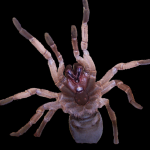pesticide
Image of honeybee By Fir0002 (Own work) [GFDL 1.2 (http://www.gnu.org/licenses/old-licenses/fdl-1.2.html)], via Wikimedia Commons
A new study conducted by researchers at the University of Guelph found that the use of certain pesticides impacts wildflower pollination by bees. According to a quote by study author Nigel Raine, published in CBCNews, the use of neonicotinoid-type pesticides "modify the way in which information flows through the nervous system."
The research team found that bees gather pollen more frequently, but less efficiently, when exposed to the pesticide compared to bees…
If there's one thing that antivaccine activists share in common, it's the passionate (and as yet unproven) belief that "something" out there in the environment caused the "autism epidemic." Usually, that "something" thought to be vaccines, but with the utter failure of the vaccine-autism hypothesis to the point where it is considered soundly refuted, antivaccinationists have gotten a bit more—shall we say?—creative. Now it's something in the environment. Sometimes it's mercury, despite the utter lack of evidence that mercury in vaccines is even remotely linked to autism. Sometimes it's…
Photo credit: Margaret C. Hardy
Drs. Glenn King and Maggie Hardy at the Institute of Molecular Bioscience, University of Queensland, Australia have discovered a small protein, aptly named orally active insecticidal peptide-1 (OAIP-1), in the venom of Australian tarantulas (Selenotypus plumipes) that can kill prey when ingested orally. According to the study, OAIP-1 is fast acting and more potent than commercial pyrethroid insecticides and is very effective at killing the agricultural pest, cotton bollworm. The authors suggest that OAIP-1 may therefore be useful as a bioinsecticide. The…
A Stanford University analysis of over 200 nutritional studies found little evidence that organic food is better for you than conventional food. But health is affected by more than vitamins and minerals; for example by the chemical chlorpyrifos, which was banned for indoor use but continues to be sprinkled on our food crops. In California’s Salinas Valley, which grows greens for the entire nation, children exposed to chlorpyrifos and other pesticides are, well, stupider. As Elizabeth Grossman writes on The Pump Handle, “the higher the exposure, the lower the IQ score.” Researchers observing…
By gluing radio chips to the backs of 800 honeybees, researchers proved that Neonicotinoid pesticides interfere with their behavior. Greg Laden reports that bees exposed to the common aphid-killer "forage abnormally, have 'olfactory memory' problems, are easily disoriented and become poor learners." Fewer of them return to the colony. Laden observes, "One thing that strikes me as especially interesting here is that many bees don't make it back over a fairly long period of time even under normal conditions, and that some bees stay out overnight!" Another likely contributor to Colony Collapse…
A commonly used insecticide, and possibly an increasingly widely used form of that pesticide, could be a causal factor in bee colony collapse. It is not 100% certain that this pesticide's effects can be counted as one of the causes this problem, but there is a very good chance that neonicotinoids can cause a drop in hive population, and thus, should be examined to see if there is a relationship in some cases. From the paper's abstract:
Nonlethal exposure of honey bees to thiamethoxam (neonicotinoid systemic pesticide) causes high mortality due to homing failure at levels that could put a…
by Elizabeth Grossman
On August 28, 2008 at 10:53 p.m., a massive explosion and fire, caused by a runaway chemical reaction, ripped through the Bayer CropScience pesticide plant in Institute, West Virginia. It killed two workers and injured eight employees, two contractors, and six fire-fighters, all of whom were treated for possible toxic chemical exposure. On January 20, 2011, the Chemical Safety and Hazard Investigation Board (CSB) released its investigation report. Each of its key findings points to a disaster waiting to happen.
The incident occurred at the facility's Methomyl-Larvin…
Mark Pendergrast writes: To kick off this book club discussion of Inside the Outbreaks, I thought I would explain briefly how I came to write the book and then suggest some possible topics for discussion.
The origin of the book goes back to an email I got in 2004 from my old high school and college friend, Andy Vernon, who wrote that I should consider writing the history of the EIS. I emailed back to say that I was honored, but what was the EIS? I had never heard of it. I knew Andy worked on tuberculosis at the CDC, but I didn't know that he had been a state-based EIS officer from 1978…
How did they catch this footage of an ANTi-pesticide protest? Here's a peek behind the scenes.
Not Exactly Pocket Science - panic aboard the Titanic, the rise of polar bears and emasculated frogs
I'm trying something new. Right from the start, I've always tried to write fairly long and detailed write-ups of new papers but this means that on any given week, there are always more stories than time and my desktop gets littered with PDFs awaiting interpretation.
So, I'm going to start doing shorter write-ups of papers that don't make the cut, linking to more detailed treatments on other quality news sources. This is something that I hope science journalists will do more of. It stems from a Twitter conversation where I asked if I should (a) write up short versions of these stories, (b)…


